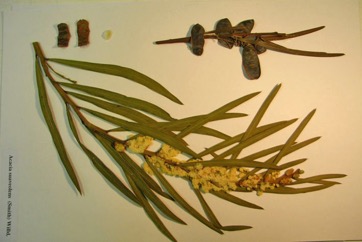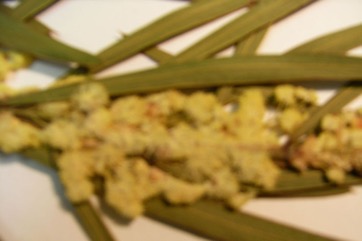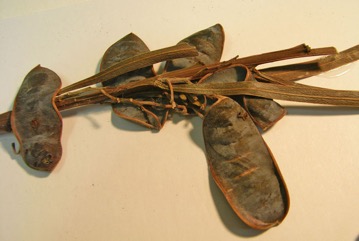Sweet scented wattle

It is a warm temperate and subtropical plant. It occurs naturally in south eastern Australia. It prefers sandy soils. It does best in an open sunny position but can grow in light shade. It is drought and frost resistant. It grows well in coastal positions but cannot tolerate salt spray. It suits hardiness zones 9-11. Tasmania Herbarium. Arboretum Tasmania.
Edible Portion
- Seeds, Leaves - tea
Where does Sweet scented wattle grow?
Found in: Australia, Tasmania
Notes: There are about 1,350 Acacia species. Over 1,000 occur in Australia. Also as Mimosaceae.
Growing Sweet scented wattle
Cultivation: It is grown from seed. The seed need treatment to break the hard seed coat. Normally this is by putting the seeds in very hot water and letting the water cool down overnight then planting the seeds immediately. It can be pruned after flowering. It can be grown from cuttings.
Edible Uses: The young seeds are steamed and eaten. The pods are not eaten, The seeds can be cooked in the pod then removed. The leaves have been used as tea. They can be used fresh or dried.
Nutrition Info
per 100g edible portion| Edible Part | Energy (kcal) | Protein (g) | Iron (mg) | Vitamin A (ug) | Vitamin c (mg) | Zinc (mg) | % Water |
|---|---|---|---|---|---|---|---|
| Seeds | - | - | - | - | - | - | |
| Leaves - tea | - | - | - | - | - | - |
Sweet scented wattle Photos



References
Bircher, A. G. & Bircher, W. H., 2000, Encyclopedia of Fruit Trees and Edible Flowering Plants in Egypt and the Subtropics. AUC Press. p 5
Bodkin, F., 1991, Encyclopedia Botanica. Cornstalk publishing, p 34
Caton, J.M. & Hardwick, R. J., 2016, Field Guide to Useful Native Plants from Temperate Australia. Harbour Publishing House. p 60
Cherikoff V. & Isaacs, J., The Bush Food Handbook. How to gather, grow, process and cook Australian Wild Foods. Ti Tree Press, Australia p 44
Collier, P., 1993, Woodland Wild flowers of Tasmania. Plant Identikit. Society for growing Australian Plants Tasmania Region. Hobart. p 43
Cronin, L., 1989, The Concise Australian Flora. Reed. p 48
Cundall, P., (ed.), 2004, Gardening Australia: flora: the gardener's bible. ABC Books. p 79
Curtis, W.M., 1956, The Students Flora of Tasmania Vol 1 p 124
Elliot, W.R., & Jones, D.L., 1982, Encyclopedia of Australian Plants suitable for cultivation. Vol 2. Lothian. p 119
Facciola, S., 1998, Cornucopia 2: a Source Book of Edible Plants. Kampong Publications, p 151
Greig, D., 1996, Flowering Natives for Home Gardens. Angus & Robertson. p 40
Grieg, D., 2002, A photographic guide to Wildflowers of South-eastern Australia. New Holland. p 68
Hardwick, R.J., 2000, Nature's Larder. A Field Guide to the Native Food Plants of the NSW South Coast. Homosapien Books. p 75
Haslam, S., 2004, Noosa's Native Plants. Noosa Integrated Catchment Assn. Inc. p 45
Hedrick, U.P., 1919, (Ed.), Sturtevant's edible plants of the world. p 21
Lord, E.E., & Willis, J.H., 1999, Shrubs and Trees for Australian gardens. Lothian. p 42
Low, T., 1991, Wild Food Plants of Australia. Australian Nature FieldGuide, Angus & Robertson. p 41
Low, T., 1992, Bush Tucker. Australia’s Wild Food Harvest. Angus & Robertson. p 34
Sp. pl. 4(2):1050. 1806
Tasmanian Herbarium Vascular Plants list p 39
Whiting, J. et al, 2004, Tasmania's Natural Flora. Tasmania's Natural Flora Editorial Committee PO Box 194, Ulverstone, Tasmania, Australia 7315 p 215
Williams, K.A.W., 1999, Native Plants of Queensland Volume 4. Keith A.W. Williams North Ipswich, Australia. p 36
Woolmore, E et al, 2002, King Island Flora: A Field Guide. p 58